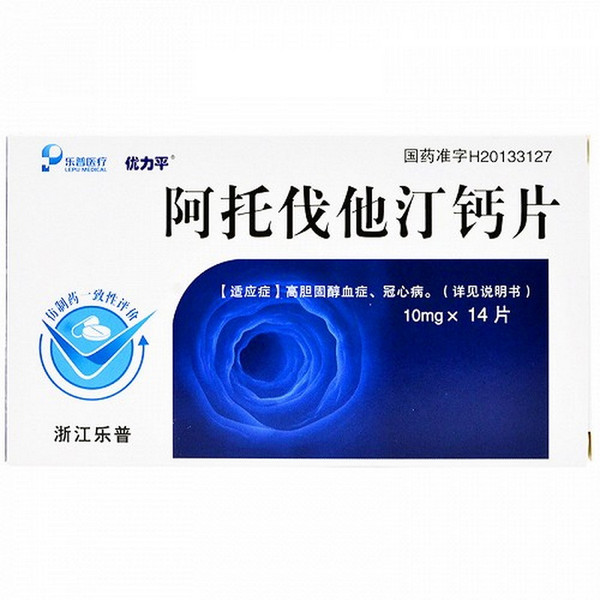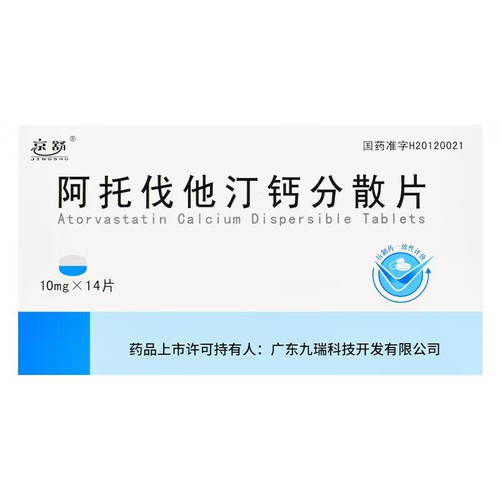Product Overview
[Drug Name]
Generic Name: Atorvastatin Calcium Tablets
Trade Name: Atorvastatin Calcium Tablets (10mg x 14 tablets)
Pinyin Full Code: ATuoFaTaTingGaiPian 10mg x 14s
[Main Ingredient]
Atorvastatin calcium. The chemical name of this product is: [R-(R',R')]-2-(4-fluorophenyl)-dihydroxy-5-(1-methylethyl)-3-phenyl-4-[(anilino)carbonyl]-1-hydro-pyrrole-1-heptanoate calcium trihydrate.
[Properties]
This product is a white film-coated tablet. After removing the film coating, the tablet appears white.
[Indications/Main Functions]
For the treatment of hypercholesterolemia and combined hyperlipidemia; prevention and treatment of coronary heart disease and stroke.
[Specifications]
10mg x 14 tablets
[Dosage and Administration]
Oral administration, one tablet once daily, or as directed by a physician. Patients should follow a standard low-cholesterol diet before and during treatment with atorvastatin calcium. The recommended starting dose of atorvastatin calcium is 10 mg/day, with a range of 10 to 60 mg/day. Lipid levels should be monitored within 2-4 weeks of treatment, and the dose adjusted accordingly based on treatment goals and response. This product is well tolerated, and adverse reactions are generally mild and transient. An international clinical study of 2,502 patients showed that less than 2% of patients discontinued treatment due to adverse reactions. The most common side effects were constipation, flatulence, dyspepsia, and abdominal pain. Mild elevations in serum transaminases and creatine phosphokinase may occur occasionally, but these generally do not require discontinuation. Fewer than 2% of patients experience the following adverse reactions: gastritis, gastroenteritis, dry mouth, anorexia, leg cramps, myositis, muscle weakness, fever, malaise, photosensitivity, drowsiness, amnesia, frequent dreams, decreased libido, orthostatic hypotension, and palpitations.
[Adverse Reactions]
This product is well tolerated, and adverse reactions are generally mild and transient. A clinical study of 2,502 patients internationally showed that less than 2% of patients discontinued medication due to adverse reactions. The most common side effects were constipation, flatulence, indigestion, and abdominal pain. Mild elevations in serum transaminases and creatine phosphokinase may occasionally occur, but generally do not require discontinuation. Fewer than 2% of patients experienced the following adverse reactions: gastritis, gastroenteritis, dry mouth, anorexia, leg cramps, myositis, muscle weakness, fever, malaise, photosensitivity, drowsiness, amnesia, frequent dreams, decreased libido, orthostatic hypotension, and palpitations.
[Contraindications]
1. Hypersensitivity to this product. 2. Active liver disease or persistently elevated serum transaminases of unknown cause. 3. Pregnant and peripartum women.
[Drug Interactions]
1. Concomitant use of this product with oral anticoagulants may prolong the prothrombin time and increase the risk of bleeding. 2. Concomitant use of this drug with immunosuppressants such as cyclosporine, erythromycin, gemfibrozil, and niacin may increase the risk of myolysis and acute renal failure. 3. Colestipol and cholestyramine may reduce the bioavailability of this drug; therefore, this drug should be taken 4 hours after the former.
[Precautions]
1. Because cholesterol and its biosynthesis products are essential for fetal development (including cholesterol and cell membrane synthesis), and atorvastatin calcium can reduce cholesterol and its biosynthesis, this drug should only be used by women of childbearing age if pregnancy is highly unlikely and the potential risks of the drug are understood. If pregnancy occurs during treatment, the drug should be discontinued and the patient informed of the potential risk to the fetus. 2. HMG-CoA reductase inhibitors, like other lipid-lowering drugs, are associated with biochemical abnormalities in liver function. It is recommended that liver function be measured before treatment, 6 weeks and 12 weeks after the start of treatment, or when the dose is increased. During long-term treatment, liver function should be measured regularly (e.g., annually). Liver enzyme changes usually occur in the first three months of using atorvastatin calcium. Patients with elevated liver enzymes should have their doses adjusted until they recover. When ALT or AST increases more than 3 times the normal level, it is recommended to reduce the dose or stop the drug. Patients who drink large amounts of alcohol or have a history of liver disease should use atorvastatin calcium with caution. 3. When patients have widespread myalgia, muscle tension, muscle weakness or a significant increase in CPK, it should be considered whether it is caused by myopathy. Patients should report unexplained myalgia, muscle tension or weakness at any time, especially when they feel unwell and have a fever. When CPK levels are significantly elevated, myopathy is confirmed or suspected, atorvastatin calcium treatment should be discontinued. 4. Concomitant use of other similar drugs with cyclosporine, folic acid biologics, erythromycin, niacin, or azole antifungals increases the risk of myopathy. Physicians considering the combination of atorvastatin calcium with these drugs should carefully weigh the risks and benefits and closely monitor patients for symptoms such as myalgia, tightness, or weakness, especially during the initial treatment phase and when increasing the dose of any drug. Regular CPK testing may also be recommended, but this does not guarantee the prevention of severe myopathy. Atorvastatin calcium should be discontinued in patients with acute, severe symptoms suggestive of myopathy or risk factors for acute renal failure secondary to rhabdomyosarcoma (such as severe acute infection, major surgery, injury, severe metabolic, endocrine, or electrolyte disturbances, and uncontrolled seizures). Caution should be exercised when using HMG-CoA reductase inhibitors concomitantly with drugs that may decrease the levels or activity of endogenous steroid hormones, such as spironolactone.
[Pediatric Use]
Use in children is limited, and long-term safety has not been established.
[Elderly Use]
Dose adjustment is required for elderly patients based on hepatic and renal function.
[Overdose]
Unknown.
[Pharmacology and Toxicology]
Antipyrine: Because atorvastatin calcium does not affect the metabolism of antipyrine, it does not interact with drugs metabolized by the same cytochrome isoenzymes. Colestipol (a lipid-lowering drug): When coadministered with atorvastatin calcium, atorvastatin calcium plasma concentrations decreased by 25%, and the reduction in LDL-C was more significant than when either drug was administered alone. Cimetidine: Coadministration did not affect atorvastatin calcium plasma concentrations or LDL-C reduction. Digoxin: When coadministered, digoxin steady-state plasma concentrations increased by 20%. Patients taking digoxin should be monitored carefully. Erythromycins: Coadministration of these two drugs in healthy individuals increased atorvastatin calcium plasma concentrations by 40%. Oral Contraceptives: Concomitant administration increases the area under the curve (AUC) for oral norethindrone and ethinyl estradiol by 30% and 20%, respectively. Women taking atorvastatin calcium should consider this when choosing an oral contraceptive. Warfarin: Atorvastatin calcium has no effect on clotting times in patients taking warfarin. Other Concomitant Therapies: No clinically adverse interactions have been observed with the concomitant administration of atorvastatin calcium for antihypertensive and estrogen replacement therapy.







